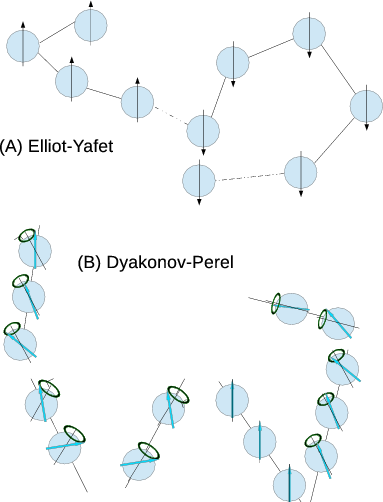
The mechanisms of decay for a spin polarized population can be broadly classified as spin-flip scattering (spin relaxation or spin-lattice relaxation) and spin dephasing (or spin decoherence) [131]. The different mechanisms responsible for the spin relaxation time is now discussed [131].
- Elliot-Yafet (EY) mechanism, for elemental metals and semiconductors (c.f. Figure 2.3).
- D’yakonov-Perel’ (DP) mechanism, for semiconductors without center of inversion symmetry (c.f. Figure 2.3).
- Bir-Aronov-Pikus mechanism, for heavily p-doped semiconductors.
- Hyperfine interaction, for electrons bound on impurity sites or confined in a quantum dot.
The EY mechanism is important for small gap semiconductors with large spin-orbit splitting [133]. In electronic band structures the up-spin and the down-spin states are mixed by the spin-orbit interaction [63], which means the up(down)-spin state contains the down(up)-spin state. The degenerate Bloch states corresponding to the lattice wave vector k in the presence of the spin-orbit coupling can be expressed as [131]:
Here, n signifies the band index. As spin mixing is usually quite small, one can
write  ≪
≪ . In the presence of such mixing spin relaxation events can be
caused by any spin-independent scattering, and in the absence of scattering events
the spin state remains conserved. This process is called the Elliott process.
However, the momentum scattering time is generally of the order of picoseconds
and the spin relaxation time several nanoseconds. The Yafet process is due to a
spin-orbit interaction in which the spin-orbit coupling of the conduction
electrons to the lattice potential can be modulated by lattice vibrations. This
leads to an interaction in which the spin of the electron is coupled to the
quantum of the lattice vibrations (phonon). Nevertheless when the EY is
the dominant scattering mechanism, a direct proportionality correlation
between the momentum scattering time and the spin relaxation time can be
found [63, 134].
. In the presence of such mixing spin relaxation events can be
caused by any spin-independent scattering, and in the absence of scattering events
the spin state remains conserved. This process is called the Elliott process.
However, the momentum scattering time is generally of the order of picoseconds
and the spin relaxation time several nanoseconds. The Yafet process is due to a
spin-orbit interaction in which the spin-orbit coupling of the conduction
electrons to the lattice potential can be modulated by lattice vibrations. This
leads to an interaction in which the spin of the electron is coupled to the
quantum of the lattice vibrations (phonon). Nevertheless when the EY is
the dominant scattering mechanism, a direct proportionality correlation
between the momentum scattering time and the spin relaxation time can be
found [63, 134].
The DP mechanism arises from the effective magnetic fields. This effective field arise from systems that lack inversion symmetry, and are classified as two types, Dresselhaus [135] and Bychkov-Rashba [136]. In the DP mechanism, the spin of moving electrons precesses due to the effective magnetic field until a scattering occurs and after a scattering event the precession angle changes. One of the major distinguishing features is that in contrary to the EY mechanism, the spin scattering rate is inversely proportional to the momentum scattering rate. There has been work on a unified theory of spin relaxation including both EY and DP dominated scattering [137]. Nevertheless, there has been promising experimental evidence that at room and elevated temperatures, the EY relaxation mechanism is the most important in silicon [67, 138].

